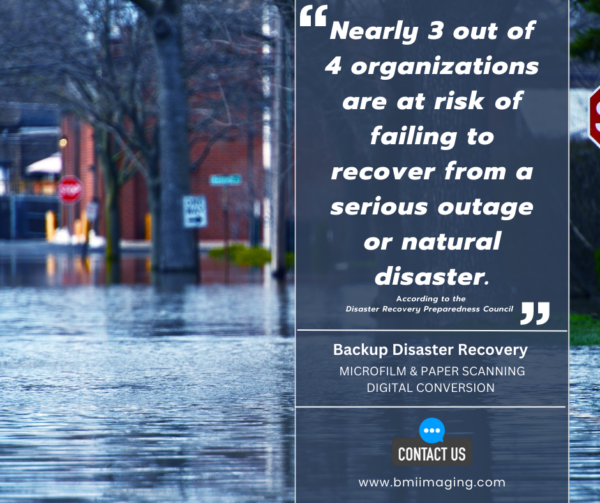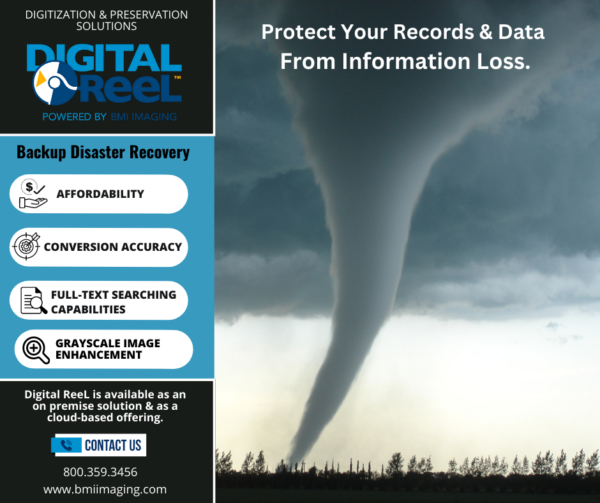You’re going to miss me when I’m gone.
Don’t let your microfilm records and data be one of the things you can’t replace when the unexpected happens.
According to the Disaster Recovery Preparedness Council, nearly 75% of organizations are at risk of failing to recover from a natural disaster or a severe power outage.
Are you one of them?

Without the proper digitization of records and a backup disaster recovery (BDR) strategy, your company will miss more than microfilm and archived files when they’re gone. It’s the content inside that holds the real value, which is why it’s crucial for organizations to be proactive with preserving their records and securing access to their microfilm for years to come.
In this blog we’ll discuss how you can preserve and protect your microfilm records, archived files, and data using the following topics:
- Why it’s important to preserve microfilm
- Identifying which records should be digitized
- Backup disaster recovery solutions
Why It’s Important To Preserve Microfilm Records
When you think about microfilm and all the content that one reel can potentially hold, the risk of information loss is serious, as are the potential liabilities you could face for not being compliant with industry standards for data protection. Preserving your microfilm records is even more critical when you realize the amount of content one reel can hold: a standard 100’ 16mm reel of microfilm contains 2,500 images! If that one reel is lost or destroyed, that could be 2,500 pieces of data gone.
Avoid the unnecessary stress by preserving your microfilm records with a backup disaster recovery system that ensures you’re files and data are protected from information loss.
Which Types Of Records Should Be Digitized?
If you’re not sure which microfilm records should be preserved and digitized, here are some suggestions:
- Documents (Deeds, Official Records, Miscellaneous Records, Vital Records)
- Indexes (Indexes to Patents, Deeds, Grantor-Grantees, Vital Records)
- Maps (Parcel, Survey, Subdivision, Assessment)
- Educational Records & Transcripts
- Historical Documents
- Census Records
- Court Records
- Newspapers
By designating the microfilm records that need to be digitized, you’re already taking a step in the right direction towards implementing a BDR plan that minimizes your risks for information loss.

Backup Disaster Recovery Solutions
After deciding which records need to be digitized, you’ll want to consider how to access them in their digital format.
Some options for your document management solutions are described below:
1/ Colocated Hosting Solution
Collocated hosting applications are great for backup disaster recovery plans.
If your data is stored locally, such as on a local network, and it gets destroyed you’ll be glad to have an off-site hosted backup; this could be essential to continued operations in the event of disaster.
Colocating your data has a number of advantages:
- First, if one of the hosting sites (the servers or network at one of the locations) goes down, the backup is still available. You won’t even know there’s an issue because you’ll still be able to access your records as normal.
- Second, the colo sites are typically separated both geographically and digitally. This means that if there’s a disaster in an area that destroys a server location, that same disaster shouldn’t affect the colo site(s).
- Lastly, speed of access is improved with colo hosting. By having multiple data centers hosting your records, access is dynamically switched between sites to get you the fastest response.
2/ Digital ReeL Preservation & Hosting Solution
Digital ReeL, our custom-built records hosting application, is the ideal solution for the permanent preservation and web-based viewing of microfilm archives.
It’s unlike any microfilm conversion solution available today due to its affordability, conversion accuracy, full-text searching capabilities, and adjustable grayscale image enhancement feature.
The user-friendly interface and simple feature set not only stores your digital records but gives you the ability to adjust the images with grayscale enhancement and optimization. With image enhancement you get to keep your costs in check and still get the results you need on a per-image basis to improve image clarity and legibility.

Next Steps
Reach out to us today! Click the “Get Your Quote” button below, fill out the form, and we’ll quickly reply to you to discuss your project.
Further Reading
“Digital Hosting & Colocation”
Are your hosted records collocated at multiple sites? Learn about the benefits of colocation and why it’s important for your data.
“Grayscale Image Enhancement: An Essential Tool For Poor Quality Records”
Digital images don’t always look perfect. Grayscale image enhancement gives you the ability to optimize images to get a better image quality.
“Digitization & The Importance Of Historical Context”
Learn various ways to capture the original historical context of your records while enjoying the immense benefits of digitization.

